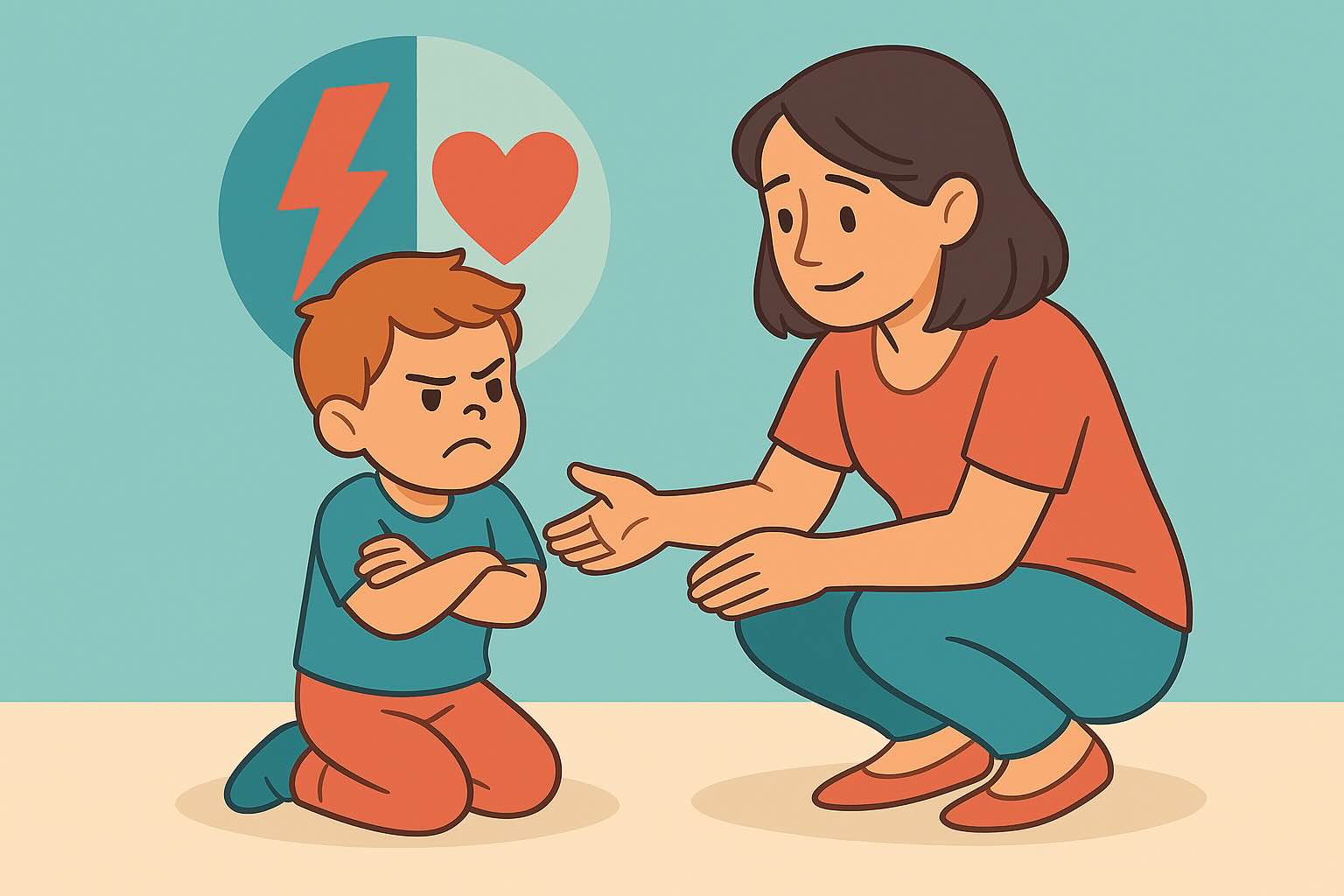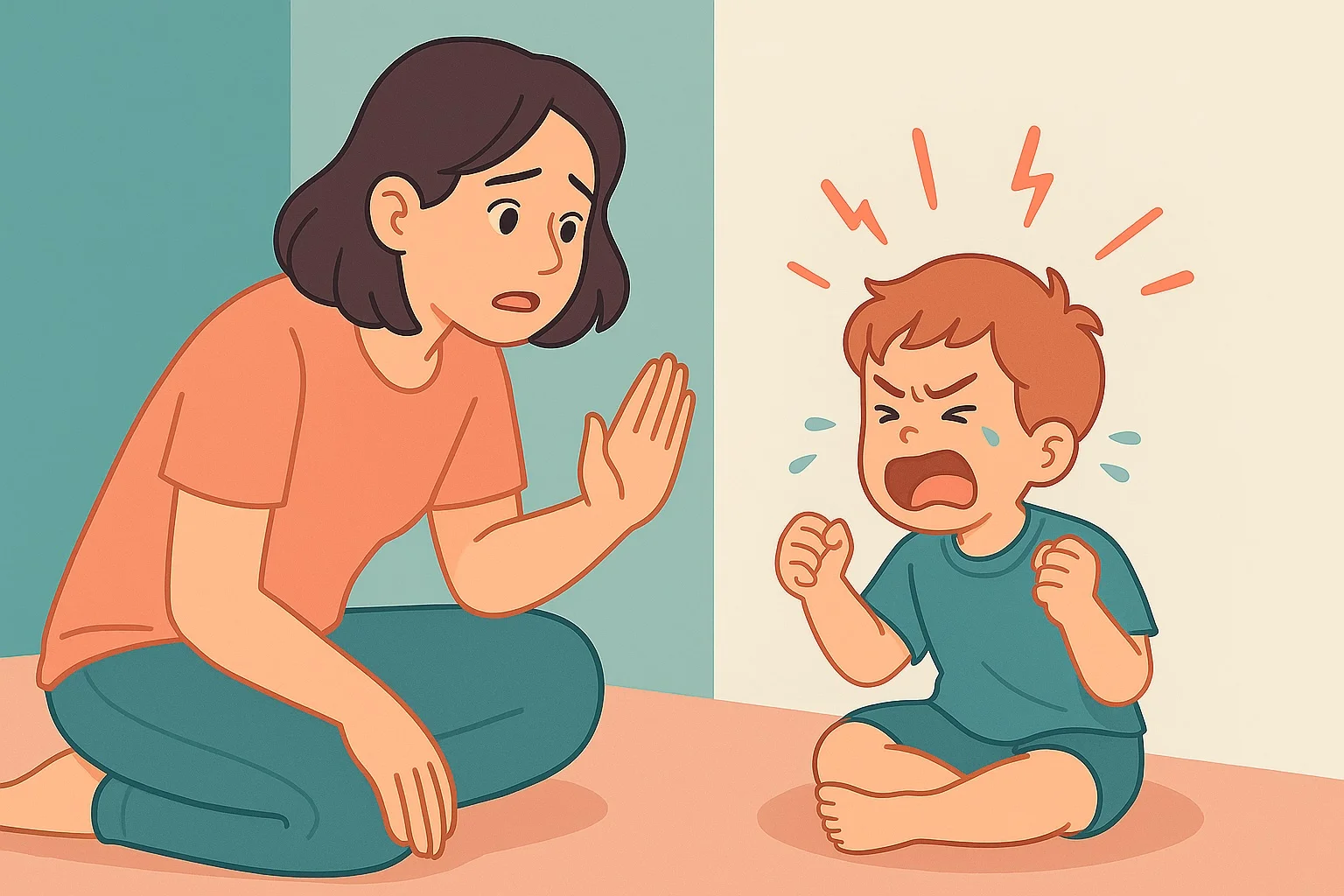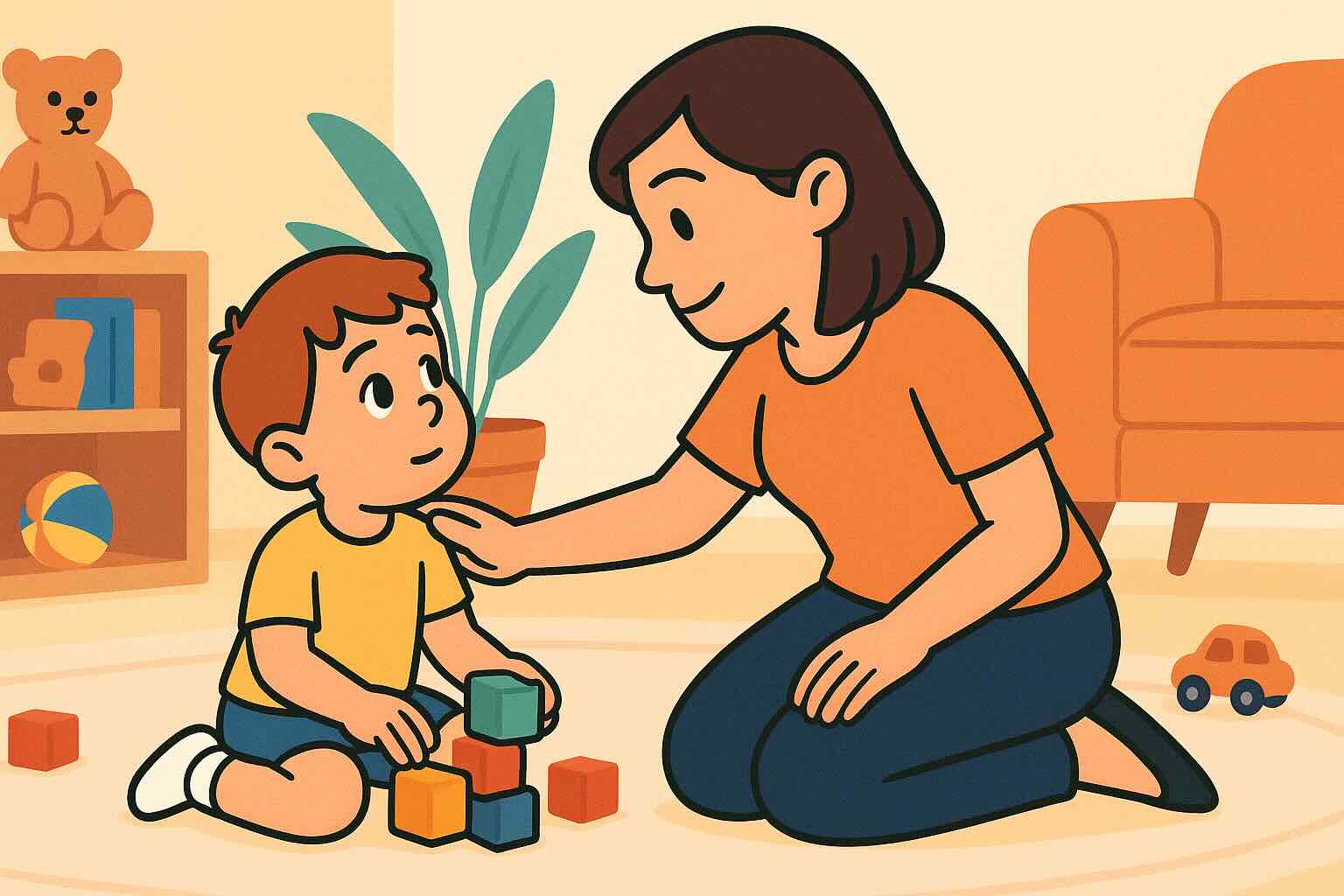How to End Power Struggles: 7 Connection Strategies


If bedtime feels like a nightly battle, getting dressed becomes a 30-minute negotiation, or every request turns into "You can't make me!" - you're not alone. Power struggles are one of the most exhausting aspects of parenting children ages 3-7, but they're also completely avoidable when you understand what's really happening beneath the surface.
Most power struggles aren't actually about the immediate issue (brushing teeth, cleaning up toys, getting in the car). They're about deeper human needs: autonomy, connection, and feeling heard and valued. When you address these underlying needs, the daily battles often dissolve naturally.
This comprehensive guide will help you understand why power struggles happen and give you practical tools to transform conflict into cooperation while maintaining the boundaries your child needs.
What You'll Learn in This Guide
- The Psychology of Power Struggles - What's really happening when children dig in their heels
- The Anatomy of a Battle - How power struggles escalate and how to interrupt the cycle
- Prevention Strategies - Setting up your family life to avoid unnecessary conflicts
- In-the-Moment Tools - What to do when you're already in a power struggle
- Age-Specific Approaches - Different strategies for 3-4 vs. 5-7 year olds
- Strong-Willed Child Strategies - Special considerations for intense personalities
- Building Long-Term Cooperation - Creating family patterns that prevent future battles
Estimated reading time: 15 minutes
Understanding the Psychology of Power Struggles
What Power Struggles Really Are
A power struggle occurs when two people become locked in a battle of wills, each trying to control the other's behavior. In families, this typically looks like:
- Parent makes a request → Child refuses → Parent insists → Child digs in deeper → Emotions escalate → Someone "wins" and someone "loses"
The key insight: Power struggles are rarely about the surface issue. They're about fundamental human needs that aren't being met.
The Four Hidden Needs Behind Power Struggles
1. Autonomy: "I need some control over my life"
Children naturally develop a need for independence and self-direction. When they feel overly controlled, they may resist even reasonable requests to reclaim some sense of personal power.
2. Connection: "I need to feel important to you"
Sometimes negative attention feels better than no attention. A child who feels disconnected might unconsciously start conflicts to ensure they have your full focus.
3. Competence: "I need to feel capable"
When expectations exceed a child's developmental abilities, or when they're not given opportunities to demonstrate competence, they may assert control through resistance.
4. Significance: "I need to matter and be heard"
Children want their thoughts, feelings, and preferences to be valued. When they feel dismissed or unheard, they may escalate their resistance to ensure their voice is acknowledged.
Why Traditional "Winning" Backfires
Many parents approach power struggles with the goal of "winning" - getting their child to comply through force, threats, or consequences. However, this approach creates several problems:
- Damages the relationship through conflict and disconnection
- Teaches children to use power-over tactics in their own relationships
- Misses opportunities to address the underlying needs
- Creates long-term resistance as children feel increasingly controlled
- Builds resentment that can last well into adolescence and adulthood
The Developmental Perspective
Power struggles are actually a normal part of healthy development, particularly during certain phases:
Ages 2-4: First major autonomy phase ("I can do it myself!") Ages 6-7: Developing logical thinking and testing adult reasoning Pre-adolescence: Preparing for greater independence
Understanding these phases helps parents see resistance as growth rather than defiance.
The Anatomy of a Power Struggle: How Battles Escalate
The Power Struggle Cycle
Understanding how conflicts escalate helps you interrupt the pattern before it becomes a full battle.
Stage 1: The Trigger
- Parent makes a request or sets a limit
- Child has an initial reaction (usually emotional)
- Parent's response determines whether this becomes a struggle
Stage 2: The Escalation
- Child refuses or resists
- Parent increases pressure (repeating, threatening, bribing)
- Child digs in deeper to maintain autonomy
- Emotions intensify on both sides
Stage 3: The Battle
- Both sides become locked in winning vs. losing
- Original issue gets lost in the conflict
- Emotions override rational thinking
- Someone eventually "wins" through force or giving up
Stage 4: The Aftermath
- Winner feels temporarily victorious but relationship is damaged
- Loser feels resentful and plans future resistance
- Underlying needs remain unaddressed
- Pattern sets up for future struggles
Interrupting the Cycle
The key to ending power struggles is catching them early and choosing a different path.
At Stage 1 (The Trigger):
- Stay calm and curious about your child's reaction
- Address the emotion first: "You seem upset about this"
- Avoid immediate escalation through threats or consequences
At Stage 2 (Early Escalation):
- Pause and breathe before responding
- Acknowledge their perspective: "You really don't want to do this right now"
- Look for win-win solutions: "How can we solve this together?"
Prevention Strategies: Setting Up Success
The Power of Proactive Connection
Children who feel deeply connected to their parents are much less likely to engage in power struggles.
Daily connection builders:
- One-on-one time: Even 10 minutes of focused attention daily
- Physical affection: Hugs, cuddles, playful touch (when welcome)
- Special rituals: Bedtime stories, morning snuggles, after-school check-ins
- Shared interests: Engage in activities your child enjoys
Offering Autonomy Within Boundaries
Give children appropriate choices and control to meet their need for autonomy before power struggles begin.
Effective choice-offering:
- Limited options: "Would you like to brush teeth before or after putting on pajamas?"
- Process choices: "Would you like to clean up quickly or take your time?"
- Sequence choices: "What would you like to do first - make your bed or get dressed?"
- Method choices: "Would you like to walk to the car or hop like a bunny?"
Creating Predictable Routines
When children know what to expect, they're less likely to resist because the routine becomes "the boss" rather than the parent.
Routine elements that reduce power struggles:
- Visual schedules: Pictures showing the sequence of activities
- Transition warnings: "In 5 minutes, it will be time to..."
- Natural endpoints: "After we read three books, it's lights out"
- Child involvement: Let them help create and modify routines
Environmental Modifications
Set up your physical environment to minimize unnecessary battles.
Power struggle prevention through environment:
- Organize spaces so children can be independent
- Remove temptations that create unnecessary conflicts
- Provide child-accessible storage for toys and belongings
- Create yes spaces where children have full autonomy
In-the-Moment Strategies: What to Do During Power Struggles
The STOP Technique
When you notice a power struggle beginning, use this acronym to reset:
S - Stop: Pause and breathe before responding T - Think: What is my child really needing right now? O - Observe: What am I feeling? What is driving my response? P - Proceed: Choose a response that addresses needs rather than battles
De-escalation Scripts
When your child refuses a request:
- "I can see you really don't want to do this right now. Help me understand what's hard about it."
- "You wish you didn't have to [brush teeth/clean up/get dressed]. What would make this easier?"
- "It seems like this doesn't feel good to you. What's going on?"
When emotions are high:
- "We're both feeling upset right now. Let's take a break and figure this out together."
- "I can see you have big feelings about this. I want to understand."
- "This feels hard for both of us. How can we solve this together?"
When they say "You can't make me!":
- "You're right, I can't make you. And this still needs to happen. How can we work together?"
- "You want to feel in control of yourself. I get that. What ideas do you have?"
- "It sounds like you need some say in how this happens. What would work for you?"
The Collaborative Problem-Solving Approach
Transform power struggles into joint problem-solving sessions.
Steps for collaborative problem-solving:
- Acknowledge the conflict: "We have a problem here"
- State both perspectives: "You don't want to clean up, and I need the living room to be safe"
- Brainstorm together: "What ideas do you have for solving this?"
- Choose a solution: "Which idea should we try first?"
- Evaluate: "How did that work? What should we try next time?"
Age-Specific Approaches to Power Struggles
Ages 3-4: The Emerging Autonomy Phase
Young children are just beginning to understand their own separateness and may resist simply to exercise their emerging sense of self.
Effective strategies for 3-4 year olds:
Offer simple choices:
- "Time to get dressed. Would you like to choose your shirt or should I?"
- "We need to leave in 5 minutes. Would you like to walk to the car or would you like me to carry you?"
Use playful approaches:
- "Your shoes are looking for your feet! Can you help them find where they belong?"
- "Let's see if we can beat the timer getting ready!"
Acknowledge their growing autonomy:
- "You're becoming so independent"
- "You want to do it yourself. I can help or wait while you try"
Common power struggles and solutions:
Getting dressed:
- Instead of: "Put your clothes on NOW!"
- Try: "Your body needs clothes. Would you like to do it yourself or would you like help?"
Leaving activities:
- Instead of: "We're leaving right now!"
- Try: "It's hard to stop playing. Should we say goodbye to the toys or take one special toy with us?"
Ages 5-7: The Logical Reasoning Phase
Children this age can understand more complex explanations and participate more fully in problem-solving, but may also become skilled negotiators.
Effective strategies for 5-7 year olds:
Involve them in rule-making:
- "What should our family rule be about screen time?"
- "How can we make sure everyone's morning routine works smoothly?"
Use logical consequences:
- "When toys aren't put away, they might get lost or broken"
- "When we take too long getting ready, we might be late for fun activities"
Appeal to their growing sense of fairness:
- "What would be fair for everyone in this situation?"
- "How can we solve this so everyone feels good about it?"
Common power struggles and solutions:
Homework and responsibilities:
- Instead of: "Do your homework or else!"
- Try: "Homework helps you learn and practice. When would be the best time for you to do it?"
Sibling conflicts:
- Instead of: "Stop fighting right now!"
- Try: "You both have ideas about how to solve this. What are some solutions you could try?"
Special Considerations for Strong-Willed Children
Understanding the Strong-Willed Temperament
Strong-willed children often have intense needs for autonomy and can become master negotiators. Rather than seeing this as a problem to fix, recognize it as a strength to channel. For children with particularly intense temperaments, our spirited child guide provides specialized strategies for high-energy, strong-willed personalities.
Characteristics of strong-willed children:
- High need for control and autonomy
- Intense emotional responses
- Persistence and determination
- Natural leadership qualities
- Sensitivity to feeling controlled or dismissed
Strategies Specifically for Strong-Willed Children
Offer meaningful choices:
- Give them control over things that don't matter to you
- "You need to clean your room. Do you want to start with clothes or toys?"
- "Bedtime is in 10 minutes. Would you like to read books or listen to music to wind down?"
Involve them in decision-making:
- "We're having trouble with morning routines. What are your ideas for making them work better?"
- "Our family needs some rules about screen time. What do you think would be fair?"
Acknowledge their perspective:
- "You have strong feelings about this. I want to understand your thinking."
- "It makes sense that you would feel that way. Here's what I'm thinking..."
Channel their leadership:
- Give them special responsibilities and authority
- Let them teach younger siblings
- Put them in charge of specific family projects
When Strong-Willed Becomes Concerning
While strong-willed behavior is normal, seek support if:
- Power struggles consume hours of your day
- Your child cannot accept any limits without major battles
- Aggressive behavior escalates during conflicts
- Family functioning is significantly impacted for months
- You feel overwhelmed and unable to cope
Building Long-Term Cooperation Patterns
The Family Meeting Solution
Regular family meetings help prevent power struggles by giving everyone a voice in family decisions.
Effective family meeting elements:
- Regular schedule: Same time weekly (Sunday afternoon works for many families)
- Agenda setting: Let family members suggest topics
- Problem-solving focus: Address challenges collaboratively
- Appreciation sharing: Acknowledge each family member's contributions
- Decision-making: Vote on family rules and changes
Creating a Collaborative Family Culture
Language that reduces power struggles:
- "How can we solve this together?" instead of "Do what I said"
- "What are your thoughts about this?" instead of "Because I said so"
- "Let's figure this out" instead of "You need to listen"
- "I'm curious about your perspective" instead of "You're being difficult"
Systems that support cooperation:
- Regular one-on-one time with each child
- Family traditions that build connection and belonging
- Shared goals and projects that require teamwork
- Celebration of individual strengths and contributions
Teaching Conflict Resolution Skills
Help children develop skills for handling disagreements without power struggles.
Conflict resolution steps for children:
- Name the problem: "We both want the same toy"
- Share perspectives: "You were playing with it, and I want a turn"
- Brainstorm solutions: "We could set a timer, or find something else to play with, or play together"
- Choose a solution: "Let's try the timer first"
- Evaluate: "How did that work for everyone?"
Transforming Your Family Dynamic: A 4-Week Plan
Week 1: Assessment and Awareness
- Track when power struggles occur and what triggers them
- Notice your own emotional reactions and responses
- Begin practicing the STOP technique
- Start offering simple choices throughout the day
Week 2: Prevention and Connection
- Implement daily connection rituals
- Create or improve family routines
- Practice de-escalation language during conflicts
- Begin involving children in problem-solving
Week 3: Collaborative Approaches
- Start weekly family meetings
- Use collaborative problem-solving for ongoing issues
- Focus on addressing underlying needs rather than surface behaviors
- Practice patience as family patterns begin to shift
Week 4: Integration and Refinement
- Evaluate which strategies are working best for your family
- Adjust approaches based on your children's individual temperaments
- Celebrate improvements in family cooperation
- Plan for maintaining new patterns long-term
When Power Struggles Persist: Getting Additional Support
Signs You May Need Professional Help
- Power struggles occur multiple times daily despite consistent efforts
- Conflicts regularly last more than 30 minutes
- Aggressive behavior escalates during power struggles
- Family functioning is severely impacted
- You feel overwhelmed, angry, or resentful most of the time
- Your child seems chronically unhappy or anxious
Types of Support Available
Family therapists can help with family dynamics and communication patterns Child psychologists can assess for underlying developmental or emotional issues Parenting coaches can provide specific strategies and ongoing support Support groups connect you with other parents facing similar challenges
The Long-Term Vision: Raising Confident, Cooperative Adults
What Happens When You Stop Fighting Power Struggles
Children who grow up in families that address their needs for autonomy, connection, and significance develop into adults who:
- Collaborate effectively in relationships and work situations
- Communicate their needs clearly and respectfully
- Problem-solve creatively rather than defaulting to conflict
- Respect others' autonomy while maintaining healthy boundaries
- Feel confident in their ability to influence their environment positively
The Ripple Effect of Peaceful Conflict Resolution
When you transform power struggles into collaborative problem-solving, you're teaching your children invaluable life skills:
- Emotional regulation during disagreements
- Perspective-taking and empathy for others
- Creative problem-solving and win-win thinking
- Communication skills for expressing needs and wants
- Leadership abilities that inspire cooperation rather than compliance
Key Takeaways: Your Power Struggle Prevention Guide
- ✅ Power struggles are about unmet needs for autonomy, connection, competence, and significance
- ✅ Prevention is more effective than trying to win battles after they start
- ✅ Collaboration beats control for building long-term cooperation
- ✅ Strong-willed children need channeling, not breaking of their natural leadership - explore our spirited child guide for intensive temperament strategies
- ✅ Age-appropriate strategies honor developmental needs and capabilities
- ✅ Family systems and routines can eliminate many unnecessary conflicts
- ✅ Your calm response determines whether conflicts escalate or resolve
- ✅ Relationship repair is always possible after power struggles occur
- ✅ Long-term cooperation is built through daily practices of respect and collaboration
Remember: Your goal isn't to eliminate all conflict - it's to transform battles into opportunities for connection, learning, and mutual respect. Every power struggle you avoid is an investment in your child's emotional intelligence and your lifelong relationship.
Related Articles
Transform your approach to discipline with these complementary strategies:
- Building Cooperation Without Rewards: Fostering Internal Motivation - Build genuine cooperation through connection and intrinsic motivation
- Setting Boundaries Without Punishment: Complete Guide - Learn to set firm, loving limits that teach responsibility
- Natural Consequences vs Punishment: Teaching Responsibility - Use natural consequences to teach life skills without battles
- Time-In vs Time-Out: Building Connection and Self-Regulation - Support children through big emotions with connection-based strategies
- Screen Time Meltdowns: Handling Transitions - Apply power struggle principles to one of the most common daily battles
- Toddler Tantrums: Complete Guide - Understand the emotional outbursts that often fuel power struggles
This article is based on child development research, family systems theory, and positive discipline principles. Individual experiences vary based on child temperament, family circumstances, and consistency of implementation. Consider professional support if power struggles significantly impact your family's wellbeing.
24/7 AI Parenting Assistant
Get instant, personalized advice with expert-curated parenting knowledge. Chat with your AI coach anytime, anywhere.

Free Tantrum Scripts
Help your toddler manage big emotions with these strategies and scripts.
Frequently Asked Questions
Need personalized support?
RootWise's AI coach can provide tailored strategies for your specific situation, available 24/7 when you need it most.
Learn More About AI Coaching →



